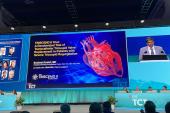Reduced Vascular Load, Better RV Function With Dapagliflozin in HFpEF
The changes seen during peak exercise alone led to better RV-PA coupling, which may be the reason for the benefit.

A new analysis, designed to shed light on the benefits of SGLT2 inhibition in patients who have heart failure with preserved ejection fraction (HFpEF), shows that dapagliflozin (Farxiga; AstraZeneca) reduces pulsatile pulmonary vascular load and improves right-sided heart function during exercise.
Right ventricle-pulmonary artery (RV-PA) coupling during peak exercise improved, report investigators, and this gain was inversely related to the magnitude of reductions in pulmonary capillary wedge pressure (PCWP).
These results help extend the “understanding of the mechanisms of benefit with SGLT2 inhibitors beyond the left heart to include favorable secondary effects on the right ventricle and pulmonary vasculature,” write Yogesh N. V. Reddy, MBBS (Mayo Clinic, Rochester, MN), and colleagues in a paper published online this week in JAMA Cardiology.
In an editorial, Gaurav Gulati, MD (Tufts University Medical Center, Boston, MA), and Sheldon Litwin, MD (Medical University of South Carolina, Charleston), say the present study should refocus clinicians on the importance of RV-PA coupling in heart failure. “While this study was not powered for clinical endpoints, these results suggest . . . one mechanism that contributes to the reduction in heart failure hospitalization seen in large clinical trials of SGLT2 inhibitors in HFpEF,” they write.
Carlos Santos-Gallego, MD, PhD (Icahn School of Medicine at Mount Sinai, New York, NY), who wasn’t involved in the new research, also emphasized the importance of RV-PA coupling in patients with HFpEF. If one side of the RV-PA equation is off-kilter, patients would be expected to have worse clinical outcomes.
“Here, both factors are improving,” he told TCTMD. “On one side, the RV contractility is improving during exercise, not at rest, and then the second part of RV-PA coupling is the afterload, the resistance in the pulmonary artery. There’s an improvement in PA compliance, which is the ability of the pulmonary vasculature to accept additional flow.”
With exercise, flow can increase at the expense of increased PA pressure, but that would lead to patient symptoms, such as shortness of breath, said Santos-Gallego. “The beauty of this is that you’re improving pulmonary artery compliance so you’re improving the ability of the pulmonary circulation to accept the additional exercise-induced increase flow.”
Dapagliflozin for 24 Weeks
Both empagliflozin (Jardiance, Boehringer Ingelheim/Eli Lilly) and dapagliflozin are approved for patients with HFpEF on the basis of EMPEROR-PRESERVED and DELIVER, respectively. As the researchers point out, though, the mechanisms of benefit aren’t well understood. Using data from CAMEO-DAPA, the researchers wanted to investigate the impact of dapagliflozin on pulmonary vascular load and RV-PA coupling in 37 ambulatory patients (mean age 67.4 years; 65% female) with HFpEF and symptoms of exertional dyspnea.
Study participants underwent a right-sided heart catheterization at rest and during exercise (with echocardiography performed simultaneously) and were required to have an elevated PCWP ≥ 25 mm Hg during exercise. Those who met the entry criteria were randomized to treatment with dapagliflozin 10 mg once daily or placebo for 24 weeks. At the study’s completion, all participants underwent rest/exercise right-sided heart catheterization with simultaneous echo.
At rest, dapagliflozin reduced PCWP but affected neither resting RV function nor measures of steady or pulsatile vascular load.
With exercise to peak exhaustion, those treated with dapagliflozin had reductions in PCWP as well as reductions in mean PA and right atrial (RA) pressures compared with the placebo-treated patients. Treatment with dapagliflozin also led to significant improvements in pulsatile pulmonary vascular load assessed with PA compliance (placebo-corrected mean difference 0.57 mL/mm Hg) and decreased PA elastance (stiffness -0.17 mm Hg/mL) compared with placebo. Multiple measures of RV function during exercise, including markers of RV-PA coupling, were improved with dapagliflozin.
“Remarkably, one-third of patients treated with dapagliflozin no longer met HFpEF diagnostic criteria during exercise after treatment, even as they clearly had been shown to have HFpEF at enrollment,” write investigators.
The reduction in resting PCWP was strongly correlated with the reduction in mean PA pressure and moderately correlated with improvements in resting RV-PA coupling and PA elastance. The reduction in exercise PCWP was strongly linked to the reduction in mean PA pressure and moderately linked to changes in PA elastance and compliance, pulmonary artery pulsatility index (PAPI), and RV-PA coupling.
Reduction in LA Filling Pressures
Ryan Tedford, MD (Medical University of South Carolina, Charleston), speaking with TCTMD, noted that the large cardiovascular safety trials testing SGLT2 inhibitors in diabetes first showed the potential benefits of the drugs in HF, which were later confirmed in dedicated heart failure randomized trials. But “it’s one of those serendipitous situations where we’re not really sure of the mechanism or why they work,” he said. The new analysis is “an elegant physiologic study” suggesting there are direct myocardial benefits with SGLT2 inhibition in HFpEF.
He pointed out, however, that much of the improvement in RV-PA coupling seen here appears to be mediated through improvements in LV function, specifically reductions in left atrial filling pressure during exercise. In 2012, Tedford and colleagues published a study in Circulation showing that elevated left atrial pressure leads to a stiffer pulmonary vasculature, which increases pulsatile load on the RV and in turn is associated with RV dysfunction and poor clinical outcomes.
“The physiology is very important,” he told TCTMD. “Whenever I give a talk about the RV in HFpEF, I talk about the impact of an elevated left atrial pressure. I think it really speaks to the idea that we need to do whatever we can to normalize left atrial pressure, not just at rest, but also during exercise, because it does appear to be associated with a decrement in RV function.”
However, there were also hints that RV contractility may improve, such as PAPI increasing during exercise, he noted.
Like Gulati and Litwin in their editorial, Tedford said the gold standard to assess RV-PA coupling is to construct pressure-volume loops with a conductance catheter, but he also specified the echocardiographic surrogates of ventricular function coupled with hemodynamic estimates of ventricular afterload used in the present analysis are quite reasonable.
“It may not be quite as precise to convince you of the physiologic mechanism, but overall I think the findings are consistent with everything else we're seeing,” said Tedford.
Other Mechanisms of Action, Too
To TCTMD, Santos-Gallego suggested that the SGLT2 inhibitors appear to act on many fronts in HFpEF. For example, his group has previously shown that empagliflozin alters myocardial fuel metabolism, switching from glucose toward ketone bodies, free fatty acids, and branched-chain amino acids.
In addition to improved myocardial energetics, the drugs reduce interstitial volume without affecting plasma volume, which is beneficial for reducing congestion without the potential risks of hypotension. SGLT2 inhibitors also have anti-inflammatory and antioxidant properties, he said. Importantly, said Santos-Gallego, prior research has shown that SGLT2 inhibitors exert an effect on nitric oxide production, which is critical for vasodilation and pulmonary circulation and may potentially explain the improvement in RV-PA coupling.
Santos-Gallego added that he doesn’t think the changes seen in this analysis are the sole domain of dapagliflozin, adding that he believes the other SGLT2 inhibitors would exert similar effects.
In their editorial, Gulati and Litwin say that ventricular-arterial coupling has been primarily a research tool for many years, but the emergence of novel therapies, such as transcatheter tricuspid valve repair and temporary RV mechanical support devices, will require physicians to better understand RV-PA coupling and interventricular interactions. An atrial shunt, for example, could alter relationships, with the additional volume load on the RV “unmasking unfavorable RV-PA interactions.”
Santos-Gallego made a similar point, highlighting the REDUCE-LAP II trial, which showed a benefit of atrial shunt therapy in patients with latent pulmonary vascular disease that was only uncovered with exercise testing. That finding sparked the RESPONDER-HF trial.
While he applauded the CAMEO-DAPA investigators for their trial, invasive exercise testing is not used routinely in clinical practice. “However, I love the design and I think it contributes a lot,” said Santos-Gallego.
Michael O’Riordan is the Managing Editor for TCTMD. He completed his undergraduate degrees at Queen’s University in Kingston, ON, and…
Read Full BioSources
Reddy YNV, Carter RE, Sorimachi H, et al. Dapagliflozin and right ventricular-pulmonary vascular interaction: a secondary analysis of a randomized clinical trial. JAMA Cardiol. 2024;Epub ahead of print.
Gulati G, Litwin SE. The politics of HFpEF—what’s good for the left is good for the right. JAMA Cardiol. 2024;Epub ahead of print.
Disclosures
- Reddy reports receiving grants from Sleep Number, Bayer Accelerated Pulmonary Hypertension Award, United Jenesis Award, and the Earl Wood Career Development Award from Mayo Clinic.
- Santos-Gallego reports no relevant conflicts of interest.





Comments